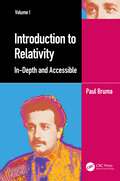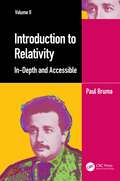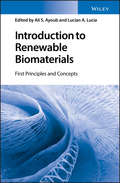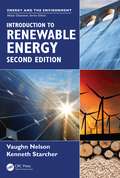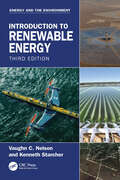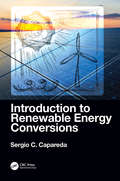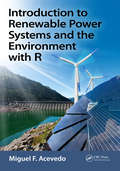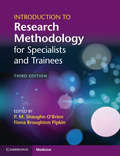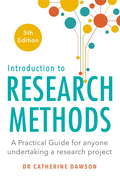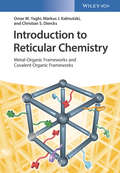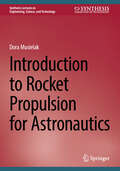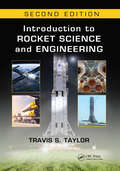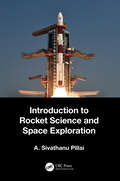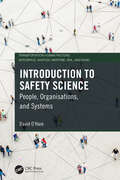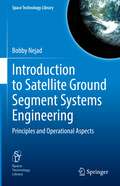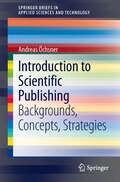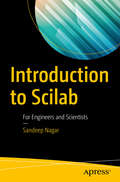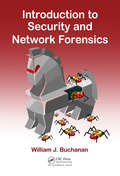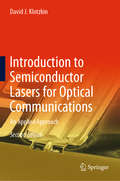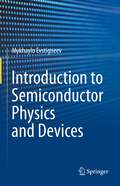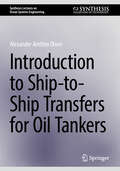- Table View
- List View
Introduction to Relativity Volume I: In-Depth and Accessible
by Paul BrumaE=mc² is known as the most famous but least understood equation in physics. This two-volume textbook illuminates this equation and much more through clear and detailed explanations, new demonstrations, a more physical approach, and a deep analysis of the concepts and postulates of Relativity. The first part of Volume I contains the whole Special Relativity theory with rigorous and complete demonstrations. The second part presents the main principles of General Relativity, including detailed explanations of the bending of light in the neighborhood of great masses, the gravitational time dilatation, and the principles leading to the famous equation of General Relativity: D(g) = k .T. The most important cosmological predictions are then described: the Big Bang theory, black holes, and gravitational waves. Plentiful historical information is contained throughout the book, particularly in an ending chapter depicting the scientific and epistemological revolution brought about by the theory of Relativity.Both volumes place an emphasis on the physical aspects of Relativity to aid the reader’s understanding and contain numerous questions and problems (147 in total). Solutions are given in a highly detailed manner to provide the maximum benefit to students. This textbook fills a gap in the literature by drawing out the physical aspects and consequences of Relativity, which are otherwise often second place to the mathematical aspects. Its concrete focus on physics allows students to gain a full understanding of the underlying concepts and cornerstones of Relativity.
Introduction to Relativity Volume II: In-Depth and Accessible
by Paul BrumaE=mc² is known as the most famous but least understood equation in physics. This two-volume textbook illuminates this equation and much more through clear and detailed explanations, new demonstrations, a more physical approach, and a deep analysis of the concepts and postulates of Relativity.Volume II contains, notably: In Special Relativity: complementary explanations, alternative demonstrations relying on more advanced means and revealing other aspects. Further topics: accelerated objects and the Relativistic force, nuclear reactions, the use of hyperbolic trigonometry, the Lagrangian approach, the Relativistic Maxwell’s equations. In General Relativity: tensors, the affine connection, the covariant derivative, the geodesic equation, the Schwarzschild solution with two of its great consequences: black holes and the bending of light; further axiomatic considerations on time, space, matter, energy and light speed. In Cosmology: the FLRW Metric, the Friedman equation, the cosmological constant, the four ideal cosmological Models. These subjects are presented in a concrete and incremental manner, and illustrated by many case studies. The emphasis is placed on the theoretical aspects, with rigorous demonstrations based on a minimum set of postulates. The mathematical tools dedicated to Relativity are carefully explained for those without an advanced mathematical background. Both volumes place an emphasis on the physical aspects of Relativity to aid the reader’s understanding and contain numerous questions and problems (147 in total). Solutions are given in a highly detailed manner to provide the maximum benefit to students. This textbook fills a gap in the literature by drawing out the physical aspects and consequences of Relativity, which are otherwise often second place to the mathematical aspects. Its concrete focus on physics allows students to gain a full understanding of the underlying concepts and cornerstones of Relativity.
Introduction to Renewable Biomaterials: First Principles and Concepts
by Lucian A. Lucia Ali S. AyoubCovers the entire evolutionary spectrum of biomass, from its genetic modification and harvesting, to conversion technologies, life cycle analysis, and its value to the current global economy This original textbook introduces readers to biomass--a renewable resource derived from forest, agriculture, and organic-based materials--which has attracted significant attention as a sustainable alternative to petrochemicals for large-scale production of fuels, materials, and chemicals. The current renaissance in the manipulation and uses of biomass has been so abrupt and focused, that very few educational textbooks actually cover these topics to any great extent. That's why this interdisciplinary text is a welcome resource for those seeking a better understanding of this new discipline. It combines the underpinning science of biomass with technology applications and sustainability considerations to provide a broad focus to its readers. Introduction to Renewable Biomaterials: First Principles and Concepts consists of eight chapters on the following topics: fundamental biochemical & biotechnological principles; principles and methodologies controlling plant growth and silviculture; fundamental science and engineering considerations; critical considerations and strategies for harvesting; first principles of pretreatment; conversion technologies; characterization methods and techniques; and life cycle analysis. Each chapter includes a glossary of terms, two to three problem sets, and boxes to highlight novel discoveries and instruments. Chapters also offer questions for further consideration and suggestions for further reading. Developed from a successful USDA funded course, run by a partnership of three US universities: BioSUCEED - BioProducts Sustainability, a University Cooperative Center for Excellence in Education Covers the entire evolutionary spectrum of biomass, from genetic modification to life cycle analysis Presents the key chemistry, biology, technology, and sustainability aspects of biomaterials Edited by a highly regarded academic team, with extensive research and teaching experience in the field Introduction to Renewable Biomaterials: First Principles and Concepts is an ideal text for advanced academics and industry professionals involved with biomass and renewable resources, bioenergy, biorefining, biotechnology, materials science, sustainable chemistry, chemical engineering, crop science and technology, agriculture.
Introduction to Renewable Energy (Energy and the Environment)
by Vaughn C. Nelson Kenneth L. StarcherIntroduction to Renewable Energy, Second Edition covers the fundamentals of renewable energy and serves as a resource to undergraduates in renewable energy courses, non-specialists within the energy industries, or anyone working to support the successful implementation of renewable energy.The second edition discusses developments that have occurred
Introduction to Renewable Energy (Energy and the Environment)
by Vaughn C. Nelson Kenneth L. StarcherIntroduction to Renewable Energy, Third Edition covers the fundamentals of renewable energy and serves as a resource to undergraduates in renewable energy courses, nonspecialists within the energy industries, or anyone working to support the successful implementation of renewable energy. This revised edition discusses developments that have occurred since the publication of the previous edition and considers the growing environmental impact of human activity on planet Earth. Dedicated to converging science and technology in a way that ensures a sustainable future, this book outlines the basics of renewable energy and focuses on current and developing policies that support the shift to renewable energy. New in the third edition, the book addresses bioenergy, energy balance, biodiesel, and photovoltaic applications, and includes an all-new chapter addressing climate change. ·Revised throughout and includes an all-new chapter on climate change. Includes color images throughout for this new edition. Adds revised end-of-chapter problems, and a solutions manual and PowerPoint slides for instructors. Includes several appendices: mathematics, exponential growth, lifetime of finite resource, order of magnitude estimates, and conversions.
Introduction to Renewable Energy Conversions
by Sergio C. CaparedaIntroduction to Renewable Energy Conversions examines all the major renewable energy conversion technologies with the goal of enabling readers to formulate realistic resource assessments. The text provides step-by-step procedures for assessing renewable energy options and then moves to the design of appropriate renewable energy strategies. The goal is for future engineers to learn the process of making resource estimates through the introduction of more than 140 solved problems and over 165 engineering related equations. More than 120 figures and numerous tables explain each renewable energy conversion type. A solutions manual, PowerPoint slides, and lab exercises are available for instructors. Key Features Covers all major types of renewable energy with comparisons for use in energy systems Builds skills for evaluating energy usage versus environmental hazards and climate change factors Presents and explains the key engineering equations used to design renewable energy systems Uses a practical approach to design and analyze renewable energy conversions Offers a solutions manual, PowerPoint slides, and lab activity plans for instructors
Introduction to Renewable Power Systems and the Environment with R
by Miguel F. AcevedoThis textbook introduces the fundamentals of renewable electrical power systems examining their direct relationships with the environment. It covers conventional power systems and opportunities for increased efficiencies and friendlier environmental interactions. While presenting state-of-the-art technology, the author uses a practical interdisciplinary approach explaining electrical, thermodynamics, and environmental topics within every chapter. This approach allows students to feel comfortable moving across these disciplines. The added value are the examples of software programs using open source systems which serve as learning tools for the concepts and techniques described in the book.
Introduction to Research Methodology for Specialists and Trainees: For Specialists And Trainees
by Fiona O’brien P. m. Shaughn Broughton PipkinHealth-centred research has changed hugely over the last ten years, from the importance of computing software to the NHS becoming more involved in research. The expectations of grant-awarding bodies, ethics committees and publishers have evolved and increased in many senses. This new edition is designed for trainee clinicians, not only those preparing for membership of the Royal College of Obstetricians and Gynaecologists (MRCOG) but also higher degree candidates and aspiring clinical academics. Chapter authors with extensive expertise make the path to embarking on research direct, straightforward and most importantly, fun and interesting; particularly aiming to support those who trained clinically and are now undertaking a research project or beginning an academic career. There remains no single book with so much relevant information gathered in a single, succinct volume. This edition now covers the wide spectrum of modern research methods for all specialities, with five supplementary chapters on major obstetric and gynaecological subspecialties.
Introduction to Research Methods 5th Edition: A Practical Guide for Anyone Undertaking a Research Project
by Catherine DawsonIntroduction to Research Methods contains everything from developing an initial idea into a proposal, through to analysing data and reporting results. Whether you have to undertake a project as part of your coursework, or as part of your employment, or simply because you are fascinated by something you have observed and want to find out more, this book offers you advice on how to turn your ideas into a workable project. Specifically it will show you how to: *Choose your research methods*Choose your participants*Prepare a research proposal*Construct questionnaires*Conduct interviews and focus groups*Analyse your data*Report your findings *Be an ethical researcher
Introduction to Research Methods 5th Edition: A Practical Guide for Anyone Undertaking a Research Project
by Dr Catherine DawsonIntroduction to Research Methods contains everything from developing an initial idea into a proposal, through to analysing data and reporting results. Whether you have to undertake a project as part of your coursework, or as part of your employment, or simply because you are fascinated by something you have observed and want to find out more, this book offers you advice on how to turn your ideas into a workable project. Specifically it will show you how to: *Choose your research methods*Choose your participants*Prepare a research proposal*Construct questionnaires*Conduct interviews and focus groups*Analyse your data*Report your findings *Be an ethical researcher
Introduction to Research Methods: A Practical Guide For Anyone Undertaking A Research Project (Electronic Resource Ser.)
by Catherine DawsonThis practical, down-to-earth guide is for researchers, students, community groups, charities or employees - in fact anyone who needs to put together research projects quickly and effectively. It contains everything from developing your idea into a proposal, through to analysing data and reporting results. Whether you have to undertake a project as part of your coursework, or as part of your employment, or simply because you are fascinated by something you have observed and want to find out more, this book offers you advice on how to turn your ideas into a workable project. Specifically it will show you how to: - choose your research methods - choose your participants - prepare a research proposal - construct questionnaires - conduct interviews and focus groups - analyse your data - report your findings - be an ethical researcher
Introduction to Research Methods: A practical guide for anyone undertaking a research project
by Dr Catherine DawsonThis practical, down-to-earth guide is for researchers, students, community groups, charities or employees - in fact anyone who needs to put together research projects quickly and effectively. It contains everything from developing your idea into a proposal, through to analysing data and reporting results. Whether you have to undertake a project as part of your coursework, or as part of your employment, or simply because you are fascinated by something you have observed and want to find out more, this book offers you advice on how to turn your ideas into a workable project. Specifically it will show you how to: - choose your research methods - choose your participants - prepare a research proposal - construct questionnaires - conduct interviews and focus groups - analyse your data - report your findings - be an ethical researcher
Introduction to Reticular Chemistry: Metal-Organic Frameworks and Covalent Organic Frameworks
by Omar M. Yaghi Markus J. Kalmutzki Christian S. DiercksA concise introduction to the chemistry and design principles behind important metal-organic frameworks and related porous materials Reticular chemistry has been applied to synthesize new classes of porous materials that are successfully used for myraid applications in areas such as gas separation, catalysis, energy, and electronics. Introduction to Reticular Chemistry gives an unique overview of the principles of the chemistry behind metal-organic frameworks (MOFs), covalent organic frameworks (COFs), and zeolitic imidazolate frameworks (ZIFs). Written by one of the pioneers in the field, this book covers all important aspects of reticular chemistry, including design and synthesis, properties and characterization, as well as current and future applications Designed to be an accessible resource, the book is written in an easy-to-understand style. It includes an extensive bibliography, and offers figures and videos of crystal structures that are available as an electronic supplement. Introduction to Reticular Chemistry: -Describes the underlying principles and design elements for the synthesis of important metal-organic frameworks (MOFs) and related materials -Discusses both real-life and future applications in various fields, such as clean energy and water adsorption -Offers all graphic material on a companion website -Provides first-hand knowledge by Omar Yaghi, one of the pioneers in the field, and his team. Aimed at graduate students in chemistry, structural chemists, inorganic chemists, organic chemists, catalytic chemists, and others, Introduction to Reticular Chemistry is a groundbreaking book that explores the chemistry principles and applications of MOFs, COFs, and ZIFs.
Introduction to Rocket Propulsion for Astronautics (Synthesis Lectures on Engineering, Science, and Technology)
by Dora MusielakThis book discusses the basic principles, performance, and technologies unique to the propulsion systems that power space vehicles. It is intended as a stimulating and accessible way in to the subject, aiming for a clear understanding of basic principles, providing a description of propulsion key physical mechanisms, and emphasizing the current state of technologies for the different applications such as launch vehicles, and space probes. The seven chapters comprise the wide scope of space rocket propulsion, filtered to highlight the main ideas without sacrificing the most important results.
Introduction to Rocket Science and Engineering (Second Edition)
by Travis S. TaylorIntroduction to Rocket Science and Engineering, Second Edition, presents the history and basics of rocket science, and examines design, experimentation, testing, and applications. Exploring how rockets work, the book covers the concepts of thrust, momentum, impulse, and the rocket equation, along with the rocket engine, its components, and the physics involved in the generation of the propulsive force. The text also presents several different types of rocket engines and discusses the testing of rocket components, subsystems, systems, and complete products. The final chapter stresses the importance for rocket scientists and engineers to creatively deal with the complexities of rocketry.
Introduction to Rocket Science and Space Exploration
by A. Sivathanu PillaiThe growing demand of space services for imaging, mobile communication, global positioning systems and disaster management, life extension of satellites by fueling, space station operations, deflecting incoming asteroids, and reducing debris from orbits, requires reusable rockets. The chapters in the book cover understanding of the universe, history of rockets, space missions, satellites, the principle of rocketry, its design and development, rocket technology, the solar system, the environment and protection of earth, and thoughts on Earth 2.0. Features: Explores the link between universe, space exploration, and rocketry. Discusses topics such as protection of the Earth from asteroids, debris, and global warming. Includes basic methodology to be adopted to design rockets for various applications. Covers use of multi-objective optimisation to realise a system and differences in design philosophies for satellite launch. Examines material on environmental protection of the Earth. This book is aimed at senior undergraduates and professionals in aerospace engineering.
Introduction to Safety Science: People, Organisations, and Systems (Transportation Human Factors)
by David Peter O'HareThe book is designed as an accessible and readable introduction to a rapidly expanding area that is in demand worldwide. A variety of professionals from different backgrounds are being tasked with managing health and safety risks in a wide variety of settings. Many lack current and up-to-date knowledge of the key developments that have taken place in Safety Science in recent decades, as well as a sense of how these developments fit in with previous approaches. This book takes readers on a ‘journey’ across three broad developments in safety science. It covers topics that focus on the individual including human error, risk and the role of cognition in human performance. It then shifts to research in safety science that uses organizations as the basic unit of analysis, questions about organizational decision making and the characteristics that dispose towards or against organizational failure and it introduces perspectives based on systems science that address issues that arise out of complexity and interdependence. Those who will purchase this book are students taking courses in human factors, ergonomics, applied psychology, occupational health and safety management. Professionals working in safety management in any field from agriculture, construction, shipping, aviation, power generation, oil exploration, manufacturing to healthcare will find this book useful, as well as general readers interested in why systems fail.
Introduction to Satellite Ground Segment Systems Engineering: Principles and Operational Aspects (Space Technology Library #41)
by Bobby NejadThe ground segment is the fundamental backbone of every satellite project, yet it is usually not visible to the public or the end user of a satellite service. Also the bulk of existing published space literature tends to focus on the satellite or its subsystems. This book tries to fill this gap and addresses systems engineering concepts applied to the design, development, qualification, and deployment of the ground control segment required to operate a single satellite, a constellation, or even a manned space vehicle. The domain of ground segment engineering has significantly evolved in recent years, mainly driven by major advances in the IT sector. Hardware virtualisation or the availability of on-demand cloud computing services are typical examples of new technologies that have changed fundamental architectural concepts previously standard in heritage ground segments. Furthermore, the stark increase of cyber attacks - today a major risk to almost all critical IT based infrastructure - has made a cyber threat resilient architecture to become one of the indispensable design requirements for ground segment engineers. The new mega constellations recently put into space deploying up to several hundred of flying objects have put very demanding needs on the ground segment for automated satellite operations. These topics and more are addressed in the book’s chapters, along with a detailed explanation of the most relevant components of a typical ground segment architecture. The basic functional requirements, design features, and the most important ground and space segment interfaces are addressed and explained in detail, supported by a wealth of figures for easier understanding. This book is kept at an introductory level, allowing newcomers to get familiar with this fairly complex subject matter. It is therefore suitable for graduate students, but can equally serve as a valuable source of information for already experienced space engineers who seek to gain a deeper understanding of the ground segment infrastructure and related systems engineering processes. It can also help project managers to better interact with their systems engineers, satellite developers to define their ground segment interfaces, and satellite operators to improve their flight and ground procedures. It is very well suited for everyone intending to start a career in satellite ground segment systems engineering.
Introduction to Scientific Publishing: Backgrounds, Concepts, Strategies
by Andreas ÖchsnerThis book is a very concise introduction to the basic knowledge of scientific publishing. It starts with the basics of writing a scientific paper, and recalls the different types of scientific documents. In gives an overview on the major scientific publishing companies and different business models. The book also introduces to abstracting and indexing services and how they can be used for the evaluation of science, scientists, and institutions. Last but not least, this short book faces the problem of plagiarism and publication ethics.
Introduction to Scilab
by Sandeep NagarFamiliarize yourself with Scilab using this concise, practical tutorial that is focused on writing code to learn concepts. Starting from the basics, this book covers array-based computing, plotting, and working with files in Scilab. Introduction to Scilab is useful for industry engineers, researchers, and students who are looking for open-source solutions for numerical computation. In this book you will learn by doing, avoiding technical jargon, which makes the concepts easy to learn. First you'll see how to run basic calculations, absorbing technical complexities incrementally as you progress toward advanced topics. Throughout, the language is kept simple to ensure that readers at all levels can grasp the concepts. After reading this book, you will come away with sample code that can be re-purposed and applied to your own projects using Scilab. What You'll Learn Apply sample code to your engineering or science problems Work with Scilab arrays, functions, and loops Use Scilab's plotting functions for data visualization Solve numerical computing and computational engineering problems with Scilab Who This Book Is For Engineers, scientists, researchers, and students who are new to Scilab. Some prior programming experience would be helpful but not required.
Introduction to Security and Network Forensics
by William J. BuchananKeeping up with the latest developments in cyber security requires ongoing commitment, but without a firm foundation in the principles of computer security and digital forensics, those tasked with safeguarding private information can get lost in a turbulent and shifting sea. Providing such a foundation, Introduction to Security and N
Introduction to Semiconductor Lasers for Optical Communications: An Applied Approach
by David J. KlotzkinThis updated, second edition textbook provides a thorough and accessible treatment of semiconductor lasers from a design and engineering perspective. It includes both the physics of devices as well as the engineering, designing and testing of practical lasers. The material is presented clearly with many examples provided. Readers of the book will come to understand the finer aspects of the theory, design, fabrication and test of these devices and have an excellent background for further study of optoelectronics.
Introduction to Semiconductor Physics and Devices
by Mykhaylo EvstigneevThis classroom-tested textbook provides a self-contained one-semester course in semiconductor physics and devices that is ideal preparation for students to enter burgeoning quantum industries. Unlike other textbooks on semiconductor device physics, it provides a brief but comprehensive introduction to quantum physics and statistical physics, with derivations and explanations of the key facts that are suitable for second-year undergraduates, rather than simply postulating the main results. The book is structured into three parts, each of which can be covered in around ten lectures. The first part covers fundamental background material such as quantum and statistical physics, and elements of crystallography and band theory of solids. Since this provides a vital foundation for the rest of the text, concepts are explained and derived in more detail than in comparable texts. For example, the concepts of measurement and collapse of the wave function, which are typically omitted, are presented in this text in language accessible to second-year students. The second part covers semiconductors in and out of equilibrium, and gives details which are not commonly presented, such as a derivation of the density of states using dimensional analysis, and calculation of the concentration of ionized impurities from the grand canonical distribution. Special attention is paid to the solution of Poisson’s equation, a topic that is feared by many undergraduates but is brought back down to earth by techniques and analogies from first-year physics. Finally, in the third part, the material in parts 2 and 3 is applied to describe simple semiconductor devices, including the MOSFET, the Schottky and PN-junction diodes, and optoelectronic devices. With a wide range of exercises, this textbook is readily adoptable for an undergraduate course on semiconductor physics devices, and with its emphasis on consolidating and applying knowledge of fundamental physics, it will leave students in engineering and the physical sciences well prepared for a future where quantum industries proliferate.
Introduction to Semiconductors: From Materials to Devices
by Peter SutterThis textbook provides a new perspective on the classic topic of Semiconductor Materials and Devices. It aims at undergraduate and beginning graduate students in the physical sciences and in engineering. This book combines two unique aspects: (i) Making quantum mechanical concepts broadly accessible: Rather than avoiding fundamental concepts such as electronic band structure and phonons, as is the case in the established texts on semiconductors, the book embraces and incorporates them as key building blocks. While conceptually sound and rigorous, this textbook avoids unnecessary detail to provide students with a solid understanding of key concepts while enabling rapid progress toward the learning goals. (ii) Extensive examples sourced from contemporary research: Advanced topics from the current literature (past 10 years) are included as natural extensions to each chapter of the book. These contemporary examples broaden the students&’ knowledge beyond the typical content of an introductory textbook, provide relevant literature references, and encourage further reading and self-study. In this way, the extensions help educate the students for careers in the &“post-silicon era&”. Provides a concise introduction to semiconductor materials and devices, accessible to students of varying backgrounds Makes extensive use of current, real examples to facilitate understanding and motivate further reading Prepares students for careers in semiconductor research and development, device design, and manufacturing
Introduction to Ship-to-Ship Transfers for Oil Tankers (Synthesis Lectures on Ocean Systems Engineering)
by Alexander Arnfinn OlsenThis book provides an outline of the Ship-to-Ship transfer process, and how ship’s masters and officers can conduct this inherently dangerous activity safely. It is non-technical in detail making it an ideal resource for first-year students completing their studies in nautical science, or as a refresher resource for professionals already employed in the tanker sector. Moreover, this book would serve as a good handrail for shore-based personnel involved in planning and executing ship-to-ship transfers. It would be used a mid-range textbook for apprentices, officer cadets posted to crude/gas carriers. Due to its non-technical approach, accessible style and nature, the book would be good resource for students and teachers/trainers in the maritime field.
